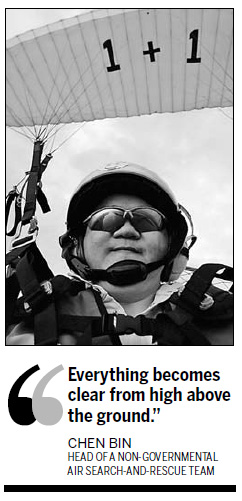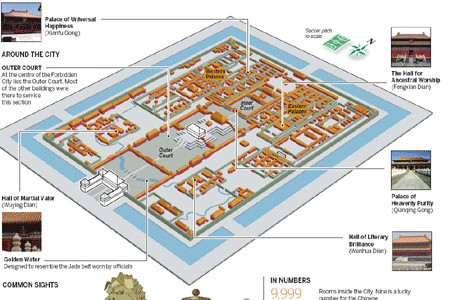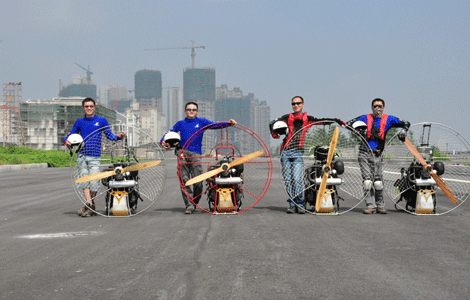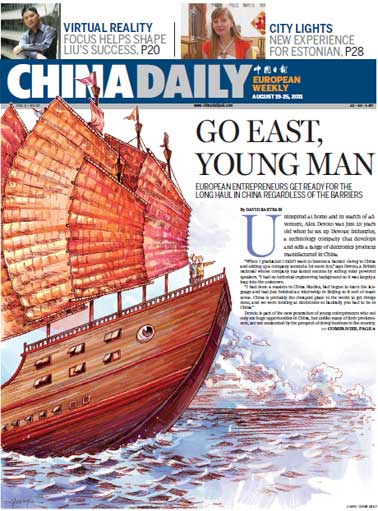Society
The life savers
Updated: 2011-09-06 07:58
By Cheng Anqi (China Daily)
|
Equipped with paramotors, Chen Bin (second left) and other members of a non-governmental air search-and-rescue team in Cangnan county, Wenzhou, Zhejiang province. [Photos Provided to China Daily] |
 |
Public-spirited residents of a small county in Wenzhou are stepping in to join disaster rescue efforts. Cheng Anqi reports.
At 6:30 am on July 24, about 10 hours after the train collision in Wenzhou, Zhejiang province, Chen Bin arrived on the scene. Hovering 70 meters above ground on his 25 kg paramotor, Chen began taking pictures of the disaster site. "It was a terrible scene. The first few cars were hanging under the bridge," Chen says.
An insurance clerk, Chen and his non-governmental air search-and-rescue team in Cangnan county, Wenzhou, managed to pull seven people out of the wreckage.
Chen was part of a group of volunteers from the county's first non-governmental underwater rescue team led by professional dive instructor Lai Shingle, as well as Cangnan One & One Emergency Management Center (OEMC) founded by Zhang Binggou.
All three non-governmental organizations (NGOs) comprise ordinary people with an extraordinary sense of social responsibility.
Chen says he has always been fascinated by nature photography and once decided to capture his hometown on film from a new angle.
In 2008, the shutterbug spent 100,000 yuan ($15,657) on a paramotor so he could view the whole city from above.
One day, while gliding over a house he intended to buy, a strong stench filled his nostrils. As he explored the site for the source of this vile smell, he spotted a factory discharging waste gas.
"Nobody at ground level knew about it as there were quite a few green spaces separating it from the residential neighborhood."
In 2009, Chen began to fly over the city's Wenruitang River, to zero in on enterprises discharging pollutants into the river.
He took his videos and photos to the local environment protection bureau so they could investigate further.
"Everything becomes clear from high above the ground," he says.
Zhang, of OEMC, Wenzhou's first registered NGO, says it now has 33 rescue teams that help with flood control, and provide emergency medical treatment and post-disaster psychological counseling.
Volunteers range from white-collar workers and civil servants to businessmen and migrant workers.
"They are all experts in their own fields," says Zhang, who was once a freelancer reporter.
Cangnan is a place prone to frequent typhoons and Zhang says, "I was saddened to see the locals suffering, even dying, owing to lack of timely rescue. I wanted to do something to help."
He became increasingly aware that communication tools, such as cell phones, became ineffective in a typhoon and the lack of emergency vehicles made matters worse.
In May 2007, he established a taxi flood-control-and-rescue team after discovering that all taxis were equipped with global positioning system (GPS) devices.
"Taxi drivers are very familiar with the roads and with GPS help, can play a crucial role when typhoons strike," Zhang says.
Two months later, he teamed up with a local taxi company to found the first flood-and-typhoon control rescue team of 128 drivers, who became the earliest batch of volunteers.
Every time a typhoon lashes Cangnan, hundreds of volunteers come together to evacuate fishermen and people living in low-lying areas to 15 safe zones, where they are provided with straw mats, bedding and flashlights.
Like other grassroot NGOs, Zhang's is cash strapped, but since 2009, the local authorities have provided logistics support.
Providing psychological counseling has also been a challenge in a county where six dialects are spoken.
"We try to attract volunteers familiar with the culture, geography and dialects of the county," Zhang says.
Lin Gaocheng, director of the flood control office of Cangnan Water Conservation Bureau, says Zhang's rescue team is well trained and dutiful.
"His rescue teams are distributed though the county, so when floods come, it is convenient for him to call for rescuers and to move fast," Lin says.
E-paper

Unveiling hidden treasures
The Forbidden City, after the Great Wall, is the most recognized tourist site in China.
Short and sweet
Game for growth
Character reference
Specials

China at her fingertips
Veteran US-China relations expert says bilateral ties have withstood the test of time

The myth buster
An outsider's look at china's leaders is updated and expanded

China in vogue
How Country captured the fascination of the world's most powerful fashion player

